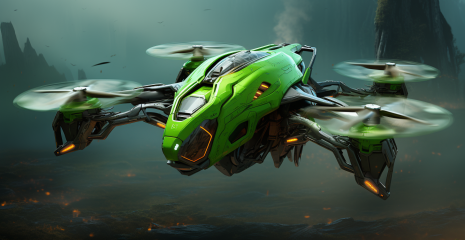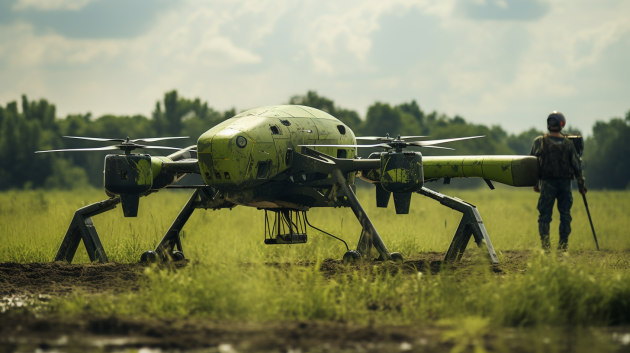

Unmanned aerial vehicles are playing a key role, changing the rules of the game on the battlefield. From reconnaissance missions to direct warfare, drones have become an integral part of the military strategy of both sides of the conflict. This article in-depth analyzes the use of UAVs in war, revealing their technical characteristics, strategic importance and influence on the course of hostilities

The airplane-shaped Russian drones are catapulted into flight and then held in the air for up to 16 hours by a noisy, fuel-powered engine. Fixed-wing drones use cameras and sensors mostly to adjust artillery fire and find enemy movement, but the aircraft have been documented dropping a few bombs from pods under their wings.
Orlan is also reportedly capable of jamming local cell towers and “SMS bombing” enemy troops. Since 2014, Ukrainian soldiers on the front lines fighting Russian-backed separatists have started receiving grim text messages warning them to lay down their arms.
The Turkish-made drones were initially seen as a watershed moment for Ukraine when video showed Bayraktars destroying valuable Russian equipment with baseball bat-sized “micromunitions” during the first chaotic days of the Russian invasion.
The song about the Bayraktars became a popular tune for buses on the streets of Ukraine, and European civilians raised funds for the delivery of new planes to Ukraine. But as the Russian invasion slowed and air defense echelons were established in the occupied territories, the drones became increasingly vulnerable.
This non-lethal drone, which Russia calls an “equipment lifting system,” is designed to hover in place and cannot move beyond the length of an electrical cable connected to a command station on the ground that powers the drone. That harness limits the coffee-table-sized quadcopter’s altitude to about 70 meters, but allows it to stay in the air for a claimed period of three days before it has to land for a maintenance check. The Quasi-Machta is equipped with a camera and telecommunications equipment that allows it to serve as a kind of “mast” that can be moved quickly and is less vulnerable to artillery attacks.
These American “suicide drones” weigh only 2.5 kilograms, and the entire system can be carried in a backpack. The tilting blades deploy from a mortar-like tube that lifts them into the air before their wings snap into place and the propeller roars to life.
Switchblades use real-time video to target targets up to 10 kilometers away at speeds of up to 160 kilometers per hour. Flying bombs are equipped with a grenade-sized warhead capable of killing enemy fighters and damaging unarmored vehicles. In October, Iran unveiled what appears to be a direct copy of the Switchblade.
The Iranian-made, Russian-branded suicide drones are launched in small “flocks” of five or more, which may be enough to defeat some air defense systems. Flying bombs shocked the world when several bombs hit Kyiv in mid-October in front of international journalists, killing at least five people, including a pregnant woman and her husband.
Shortly after the horrific October attacks, Ukraine received advanced Western anti-aircraft missile systems. The Czech Republic also launched a crowdfunding campaign for the purchase of mobile anti-aircraft guns specifically for Ukrainians against suicide drones.
The Russian Orion has a similar silhouette to the American-made Reaper combat drone. A pronounced V-shaped tail reduces the aircraft’s radar signature by avoiding radar-catching right angles, and its slim 16m wingspan is narrow enough to improve fuel efficiency during flights of up to 24 hours. The plane was filmed firing air-to-air guided missiles.
The Orions recorded several hits on Ukrainian equipment in the weeks following the February invasion, but one was shot down by Ukrainian forces in April, which observers say would have dealt a significant blow to Russian tactics.
The Ukrainian-made R18 octocopter is designed specifically for dropping bombs. The drone was stripped of all but the essential components to maximize its payload capacity of around 5 kilograms. Even the landing gear has been removed, meaning a special platform is required for takeoff and a human for landing.
The R18 can fly without illumination in the dark for complete visual stealth, using thermal imaging cameras to detect enemy troops and vehicles. Octocopter footage shows Russian tanks being destroyed by cheap armor-piercing grenades fitted with 3D-printed tail fins.
Eight-propeller octocopters like the R18 offer more reliability than conventional quadcopters. Even if one engine fails or is shot down, the octocopter can continue flying.
Chinese drone maker DJI designs its drones mostly for filmmakers and photographers, but both sides of the Ukrainian conflict are using DJI copters for reconnaissance, artillery correction and dropping small anti-personnel grenades.
The latest Mavic (pictured) features a low-quality telephoto lens that allows you to observe targets out of range, and a sharper wide-angle lens. The quadcopter is powerful enough to carry and drop individual grenades equipped with shock fuses.
But ready-made versions of drones are associated with a high risk for operators in conflict situations. DJI, the drone manufacturer, also sells a radar system specifically designed to detect DJI copters. Aeroscope radar users can pinpoint the exact location and flight path of a DJI copter.
Insect-sized unmanned aerial vehicles such as Norway’s Black Hornet , which can hover for up to 25 minutes and send images up to 1.6 kilometers using day or night vision and infrared data. They can be carried in a pocket or in a bag on a soldier’s military equipment.
Micro- and nano-drones are very small unmanned aerial vehicles (UAVs) that are typically used for specialized tasks where larger drones are ineffective or impractical. Due to their small size, micro- and nano-drones are very maneuverable, which allows them to perform tasks in limited or difficult conditions.
These drones are often used for reconnaissance, surveillance, data collection in hard-to-reach places. Many micro- and nano-drones can be controlled remotely or perform tasks autonomously.
If a wider surveillance coverage is required, a larger drone that can be launched quickly by hand is needed. An example is the AeroVironment RQ-20 “Puma”, a US-developed battery-powered, hand-launched UAV whose primary mission is surveillance and intelligence gathering using an electro-optical infrared camera.
Puma drones were included in the $300 million package of military aid to Ukraine provided by the United States in April 2022. The drone can be controlled by pilots or fly along a pre-programmed route. The drone has a range of 15 kilometers.
The vast majority of conventional military drones, the “workhorses,” are medium-sized aerial vehicles used for long-range surveillance.
An example is the Boeing ScanEagle, a long-endurance low-altitude unmanned aerial vehicle built by Insitu, a Boeing subsidiary, used for reconnaissance.
It has a range of over 100 kilometers with a flight time of over 20 hours. 15 ScanEagles were included in the package of US military assistance in arms provided to Ukraine in August 2022, worth $775 million.
Kamikaze drones, also known as unmanned aerial vehicles or suicide drones, are attack drones designed to attack a target by simply crashing into it. They may differ in complexity and capabilities.
In Ukraine, the Iranian-developed Shahed-136 /Geran 2 UAVs are the most common, which are simply UAVs with an explosive warhead that the Russian military uses to attack infrastructure in Ukraine. Special munitions have more sophisticated flight and control capabilities, warhead size and design, and on-board sensors for target identification.

